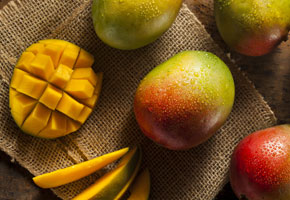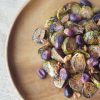
Mangos – The Fruit That Can Lower Blood Sugar!
By Dr. Daria | 4 Comments | Posted 05/16/2016
My daughter moved to Maui when she was 25 and lived there for a few years. She lived “up country” and became the most spectacular tour guide for hidden island treasures – waterfalls, bamboo jungles, mango and avocado groves, magical places! Mango season in Hawaii is about 6 months long and the sweetness and flavor is such a nice addition to the diet of the islands. Even though mangos can be messy, I love them! Actually, I loved them even before I knew about mangiferin. Mangi-what? Just follow along…
In the fruit kingdom, mangos are unique. Mangos contain a substance that has been named mangiferin, a unique antioxidant with surprising health properties. This substance was identified in the 1960s with clinical papers appearing by the 1980s and covering all sorts of health benefits. A recent study looked at the effect of adding a small amount of freeze-dried mango to the diets of 20 adults who were obese. The supplemental mango was taken for 12 weeks. After 12 weeks, blood sugar levels were significantly reduced. The subjects in the study were not diabetic but were considered to be at risk for developing the condition. Lower blood sugar levels are a good indication that eating mangos could be helpful in keeping blood sugars in check.
In an older study published in 2011, laboratory animals were fed a high-fat diet (60% of calories from fat) and another group was fed the same diet with 1% of calories coming from freeze-dried mango. The group that received the mango along with the high fat diet showed a 35% lower (healthier) blood sugar level.
In both these studies, the subjects were not diabetic. Fruits are high in sugar. We know that high blood sugar levels correlate directly with diabetes. We know that people with diabetes appropriately monitor their fruit intake. The research isn’t yet definitive about eating mangos if a person has already been diagnosed with diabetes, but for those who are concerned about someday becoming diabetic, especially if they tend to eat a lot of fat, it sounds like eating mangos is a good idea!
But wait, there’s more! Two more studies just out show promising benefits of mangiferin (the mango superstar) for:
So, there you go. If you live in Hawaii you have mango tress everywhere. It is a dietary staple when it is mango season. Here in Washington, we have mangos available all year round (and organic ones at that). These are usually imported from Mexico, Ecuador or Peru. So, they are a nice fruit anytime, and an especially good addition as our local fruits go out of season. And, for an added treat, try some freeze-dried sugar free mangos. Tasty and crunchy! Hail the mighty mango, the fruit that can lower blood sugar!
Additional Resources:
All about Mango Health Benefits
Mango Varieties and Availability


 Contact us
Contact us




























4 Responses to Mangos – The Fruit That Can Lower Blood Sugar!